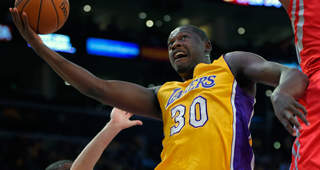As the NBA was entering an era of fluidity and position-less basketball, the 2014 draft introduced three players that might bring back some version of the power forward position.
Julius Randle, Aaron Gordon, and Jabari Parker came into the league as the evolution of that position, until Draymond Green and the Warriors interrupted that evolution. Green’s defensive versatility is by far his most valuable asset. His offensive value lies in his malleability; he personally can’t dominate offensively, but he can complement all sorts of teammates, especially the historically great ones he happens to play with.
Randle, Gordon, and Parker don’t possess the defensive skills of Green, but they are more than just malleable on offense; they have the potential to be players who can dominate one-on-one matchups every single night.
They aren’t throwback players. Less than 10 years ago they would be defined as the future of basketball. All three of them take the concept of bully-ball and add speed and skill. Imagine if Zach Randolph were faster. Imagine if Amar'e Stoudemire dribbled behind his back on the fast break. Imagine if David Lee could jump higher. These three players—all 23 years old or younger—have the tools to fit some version of those molds, and we’re likely to see that evolution sooner than later.
Randle, Gordon, and Parker are all restricted free agents this summer, and with teams like the Mavericks, Kings, Bulls, and Suns all with money to spend, all three are likely to sign significant contracts whether on their own teams or new ones. Big investments lead to opportunities for players to become their best selves.
All three are face-up forwards who can beat their defenders by taking one of the three most efficient routes: through (Randle with pure strength), around (Parker with a variety of moves including a mid-range jumper) or over (Gordon with athletic dunks). They exploit the simple matchup dilemma of a defender being either too slow or to small to guard them.
They each have their strengths: Parker is the best pure scorer of the bunch, Randle is the best rebounder, and Gordon is the most athletic and durable.
None is an excellent rim protector, which is ultimately where all their predecessors proved to be vulnerable. Lee, for example, was benched for Green in Golden State, ending his last stretch of NBA relevance. None has proven to be able to shoot from behind the three-point line either, but you can expect a big contract will come with the expectation that work will be put in in that department.
So if they have a liability, it’s less about versatility, and more about team utility. If they aren’t stretching the floor or protecting the rim do they need to play alongside role players who can perform those duties?
That’s where it becomes tough to find out if the evolution of the power forward position was simply interrupted by a couple of historically great shooting teams or if the position has become phased out as teams are realizing they only need one true big man on the floor at all times as long as he can either shoot or block shots.
But while their predecessors would be played off the court against a team like the Warriors, Randle, Gordon, and Parker could develop into becoming the keys to exploiting small-ball teams. The Warriors’ small ball lineup featuring Green at center has been historically dominant. Scarier still, is that they have proven that Kevin Durant at center can be similarly effective. No traditional center could dream of guarding Durant and his length has turned him into a formidable rim protector.
Exploiting that strategy requires relentless rebounding without sacrificing pace. Neither Randle, Gordon, nor Parker will limit their team’s pace. On the contrary, all three can take a rebound coast to coast and maintain control as if it’s second nature. And there’s no question all three have more to show for their time in the weight room than Durant does. They can all punish small-ball teams on the offensive glass.
These three might not just survive as power forwards, they can continue the evolution that was already in the process when they were still in high school. For example, any of them would be great in a pick-and-roll with, say, James Harden. But they might also be great in that same play with, say, Kristaps Porzingis. As in they would be in the ball handler in that pick-and-roll or pick-and-pop.
Finding the next Draymond Green might be a fool’s mission. He might not be out there. But will Draymond Green be able to guard the best version of Randle, Gordon, or Parker? Whichever one of them can make that question interesting is worthy of a hefty investment.



